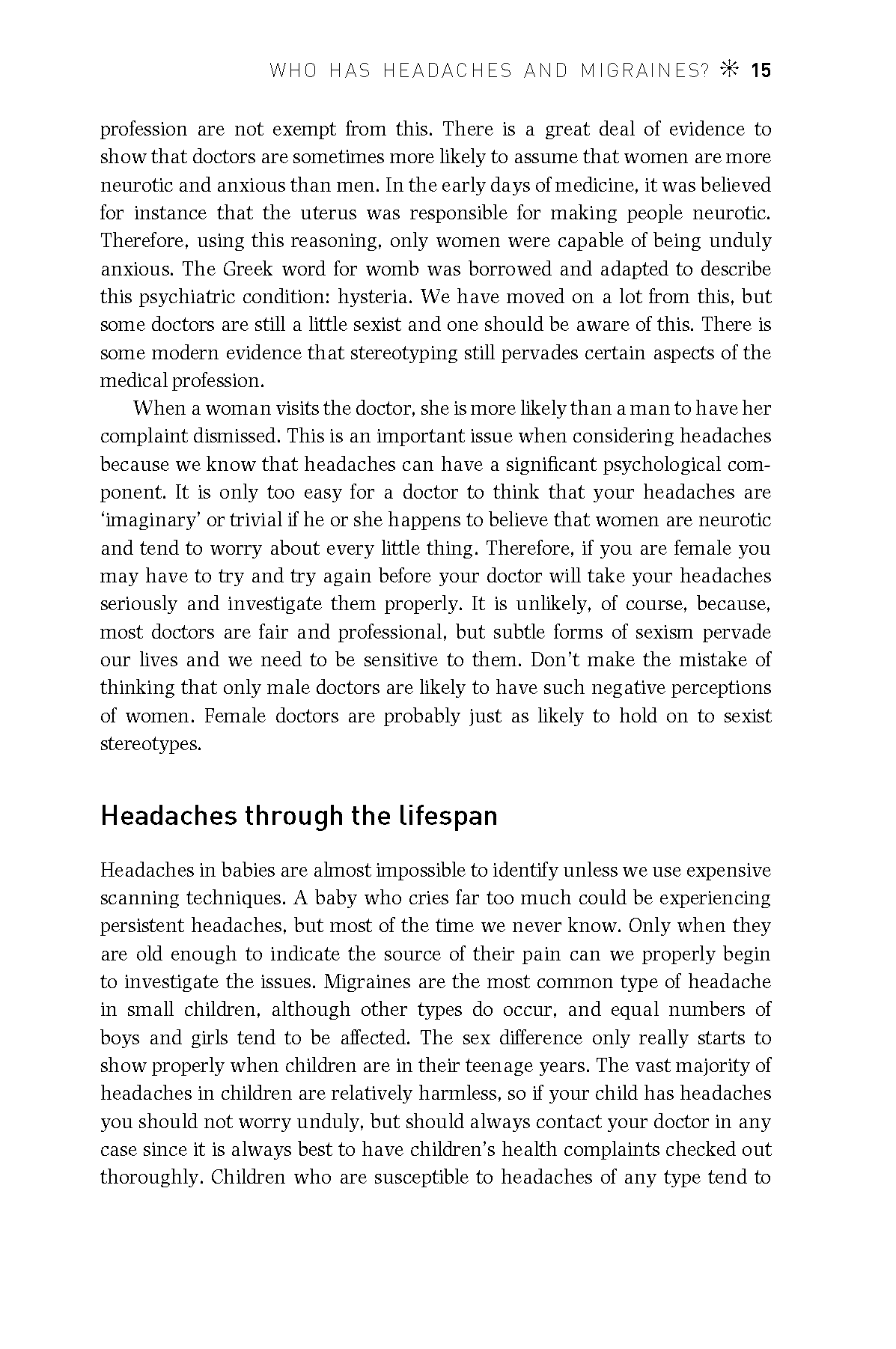UHAM032

WHO HAS HEADACHES AND M I G RAI N ES? ^ 15
profession are not exempt from this. There is a great deal of evidence to show that doctors are sometimes morę likely to assume that women are morę neurotic and anxious than men. In the early days of medicine, it was believed for instance that the uterus was responsible for making people neurotic. Therefore, using this reasoning, only women were capable of being unduly anxious. The Greek word for womb was borrowed and adapted to describe this psychiatrie condition: hysteria. We have moved on a lot from this, but some doctors are still a little sexist and one should be aware of this. There is some modern evidence that stereotyping still pervades certain aspects of the medical profession.
When a woman visitsthe doctor, she ismore likely than a manto haveher complaint dismissed. This is an important issue when considering headaches because we know that headaches can have a signiheant psychological com-ponent. It is only too easy for a doctor to think that your headaches are ‘imaginary’ or trivial if he or she happens to believe that women are neurotic and tend to worry about every little thing. Therefore, if you are female you may have to try and try again before your doctor will take your headaches seriously and investigate them properly. It is unlikely, of course, because, most doctors are fair and professional, but subtle forms of sexism pervade our lives and we need to be sensitive to them. Don’t make the mistake of thinking that only małe doctors are likely to have such negative perceptions of women. Female doctors are probably just as likely to hołd on to sexist stereotypes.
Headaches through the lifespan
Headaches in babies are almost impossible to identify unless we use expensive scanning techniąues. A baby who cries far too much could be experiencing persistent headaches, but most of the time we never know. Only when they are old enough to indicate the source of their pain can we properly begin to investigate the issues. Migraines are the most common type of headache in smali children, although other types do occur, and eąual numbers of boys and girls tend to be affected. The sex difference only really starts to show properly when children are in their teenage years. The vast majority of headaches in children are relatively harmless, so if your child has headaches you should not worry unduly, but should always contact your doctor in any case sińce it is always best to have children’s health complaints checked out thoroughly. Children who are susceptible to headaches of any type tend to
Wyszukiwarka
Podobne podstrony:
UHAM038 WHO HAS HEADACHES AND M I G RAI N ES? ^ 21 evidence of heredity, but there is by no means a
UHAM030 WHO HAS HEADACHES AND M IG RAI N ES? * 13 headaches are also often commonly associated with
UHAM034 WHO HAS HEADACHES AND M IG RAI N ES? * 17 In children especially, migraines can be felt in t
UHAM036 WHO HAS HEADACHES AND M IG RAI N ES? * 19 what is wrong with the vehicle. So when you see yo
UHAM071 54 ^ UNDERSTANDING HEADACHES AND M I G RAI N ES benign tumours are also a form of cancer. Th
UHAM031 H UNDERSTANDING HEADACHES AND M I G RAI N ES during pregnancy, especially if it is associate
UHAM019 2 ^ UNDERSTANDING HEADACHES AND M I G RAI N ES so it is with headaches. They differ in type
UHAM021 U UNDERSTANDING HEADACHES AND M I G RAI N ES can wake up still in pain. Generally, a migrain
UHAM029 12 ^ UNDERSTANDING HEADACHES AND M I G RAI N ES von Bingen. She died around 800 years ago an
UHAM083 66 ^ UNDERSTANDING HEADACHES AND M I G RAI N ES acupuncture have been shown to work for some
UHAM085 68 ^ UNDERSTANDING HEADACHES AND M I G RAI N ES the areas of the foot that correspond to the
UHAM087 70 ^ UNDERSTANDING HEADACHES AND M I G RAI N ES they ever feel really relaxed is when they a
UHAM093 76 ^ UNDERSTANDING HEADACHES AND M I G RAI N ES A good starting point for any keen reader of
UHAM095 78 ^ UNDERSTANDING HEADACHES AND M I G RAI N ES Aromatherapy: There are many aromatherapy as
więcej podobnych podstron